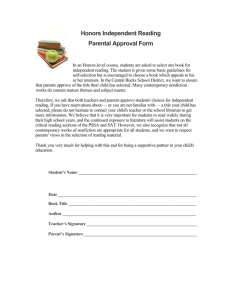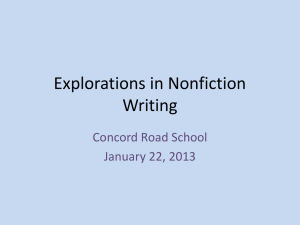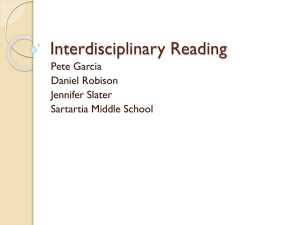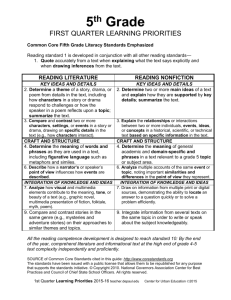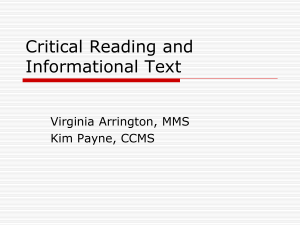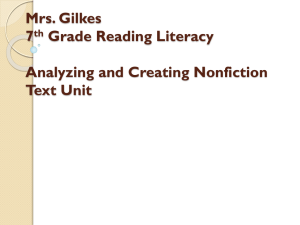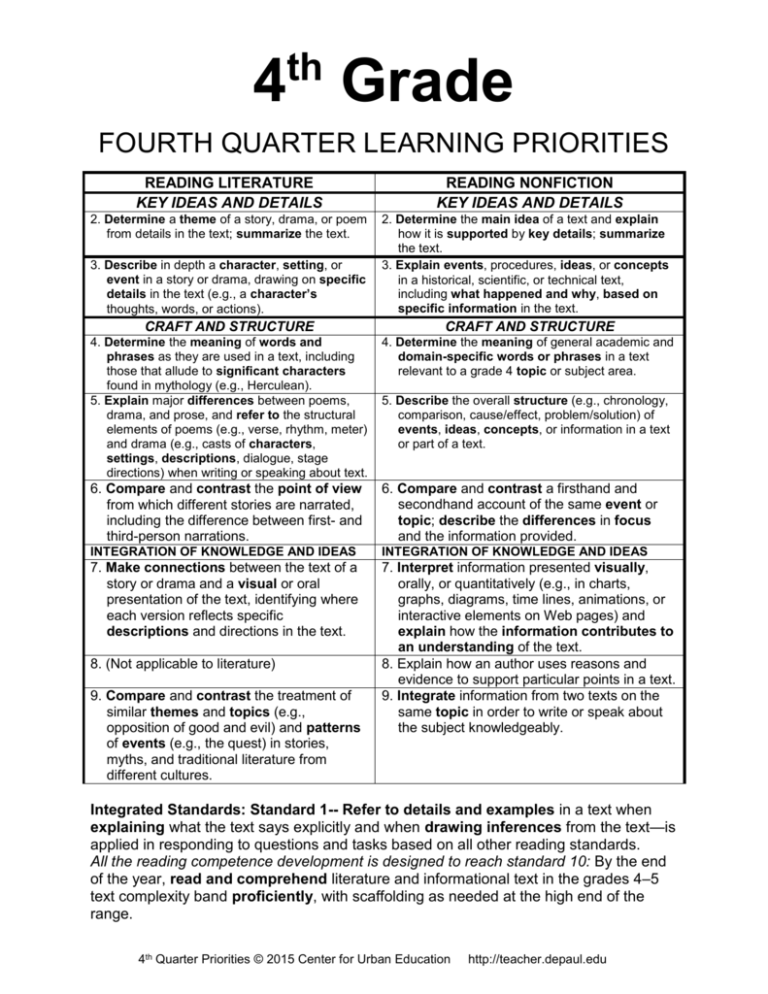
th
4 Grade
FOURTH QUARTER LEARNING PRIORITIES
READING LITERATURE
KEY IDEAS AND DETAILS
2. Determine a theme of a story, drama, or poem
from details in the text; summarize the text.
3. Describe in depth a character, setting, or
event in a story or drama, drawing on specific
details in the text (e.g., a character’s
thoughts, words, or actions).
READING NONFICTION
KEY IDEAS AND DETAILS
2. Determine the main idea of a text and explain
how it is supported by key details; summarize
the text.
3. Explain events, procedures, ideas, or concepts
in a historical, scientific, or technical text,
including what happened and why, based on
specific information in the text.
CRAFT AND STRUCTURE
CRAFT AND STRUCTURE
4. Determine the meaning of words and
phrases as they are used in a text, including
those that allude to significant characters
found in mythology (e.g., Herculean).
5. Explain major differences between poems,
drama, and prose, and refer to the structural
elements of poems (e.g., verse, rhythm, meter)
and drama (e.g., casts of characters,
settings, descriptions, dialogue, stage
directions) when writing or speaking about text.
4. Determine the meaning of general academic and
domain-specific words or phrases in a text
relevant to a grade 4 topic or subject area.
6. Compare and contrast the point of view
from which different stories are narrated,
including the difference between first- and
third-person narrations.
6. Compare and contrast a firsthand and
secondhand account of the same event or
topic; describe the differences in focus
and the information provided.
INTEGRATION OF KNOWLEDGE AND IDEAS
INTEGRATION OF KNOWLEDGE AND IDEAS
7. Make connections between the text of a
story or drama and a visual or oral
presentation of the text, identifying where
each version reflects specific
descriptions and directions in the text.
7. Interpret information presented visually,
orally, or quantitatively (e.g., in charts,
graphs, diagrams, time lines, animations, or
interactive elements on Web pages) and
explain how the information contributes to
an understanding of the text.
8. Explain how an author uses reasons and
evidence to support particular points in a text.
9. Integrate information from two texts on the
same topic in order to write or speak about
the subject knowledgeably.
8. (Not applicable to literature)
9. Compare and contrast the treatment of
similar themes and topics (e.g.,
opposition of good and evil) and patterns
of events (e.g., the quest) in stories,
myths, and traditional literature from
different cultures.
5. Describe the overall structure (e.g., chronology,
comparison, cause/effect, problem/solution) of
events, ideas, concepts, or information in a text
or part of a text.
Integrated Standards: Standard 1-- Refer to details and examples in a text when
explaining what the text says explicitly and when drawing inferences from the text—is
applied in responding to questions and tasks based on all other reading standards.
All the reading competence development is designed to reach standard 10: By the end
of the year, read and comprehend literature and informational text in the grades 4–5
text complexity band proficiently, with scaffolding as needed at the high end of the
range.
4th Quarter Priorities © 2015 Center for Urban Education
http://teacher.depaul.edu
Writing:
Common Core Writing Standards for Fourth Grade
Standards 7 and 8 and 9A are integrated into reading/writing about science and social science.
RESEARCH TO BUILD KNOWLEDGE
7. Perform short, focused research tasks that build knowledge through investigation of
different aspects of a single topic.
8. Gather relevant information from experience as well as print and digital sources, take notes
and categorize evidence, restate information in written text, and provide basic bibliographic
information.
9. Write in response to literary or informational sources, drawing evidence from the text to
support analysis and reflection as well as to describe what they have learned:
__a. Apply grade 4 reading standards to informational texts (e.g., “Explain how an author uses
evidence to support his or her claims in a text”).
__b. Apply grade 4 reading standards to literature (e.g., “Describe in detail a character, event,
or setting, drawing on specific details in the text (e.g., from a character’s thoughts, words,
deeds, and interactions with others”).
4TH Quarter Learning Priorities © 2015 Center for Urban Education
http://teacher.depaul.edu
2
Identify Speaking and Listening Standards to emphasize
this quarter.
Speaking and Listening are Keys to Learning ACROSS the Curriculum-- Students
exercise Speaking and Listening competencies as they proceed through the gradual
release of responsibility. They also will be developed as students make culminating
presentations.
Comprehension and Collaboration
SL.4.1 Engage effectively in a range of collaborative discussions (one-on-one, in groups,
and teacher-led) with diverse partners on grade 4 topics and texts, building on others’ ideas
and expressing their own clearly.
__SL.4.1a Come to discussions prepared, having read or studied required material;
explicitly draw on that preparation and other information known about the topic
to explore ideas under discussion.
__SL.4.1b Follow agreed-upon rules for discussions and carry out assigned roles.
__SL.4.1c Pose and respond to specific questions to clarify or follow up on
information, and make comments that contribute to the discussion and link to
the remarks of others.
__SL.4.1d Review the key ideas expressed and explain their own ideas and
understanding in light of the discussion.
SL.4.2 Paraphrase portions of a text read aloud or information presented in diverse media
and formats, including visually, quantitatively, and orally.
SL.4.3 Identify the reasons and evidence a speaker provides to support particular points.
Presentation of Knowledge and Ideas
SL.4.4 Report on a topic or text, tell a story, or recount an experience in an organized
manner, using appropriate facts and relevant, descriptive details to support main ideas or
themes; speak clearly at an understandable pace.
SL.4.5 Add audio recordings and visual displays to presentations when appropriate to
enhance the development of main ideas or themes.
SL.4.6 Differentiate between contexts that call for formal English (e.g., presenting ideas) and
situations where informal discourse is appropriate (e.g., small-group discussion); use formal
English when appropriate to task and situation.
SOURCE of Common Core Standards cited in this guide: http://www.corestandards.org
The standards have been issued with a public license that allows them to be republished for any purpose
that supports the standards initiative. © Copyright 2010. National Governors Association Center for Best
Practices and Council of Chief State School Officers. All rights reserved.
4TH Quarter Learning Priorities © 2015 Center for Urban Education
http://teacher.depaul.edu
3
FOURTH QUARTER MATH PROGRESS PRIORITIES
During fourth quarter, in addition to the new math that students learn, it’s important to revisit math they
mastered in the past but have not used recently. Research confirms that if the math curriculum includes
“frequent cumulative review” that enables students to retain greater math competence. Among sources
supporting this “mix” is the report “Assisting Students Struggling with Mathematics” of the What Works
Clearinghouse, IES Practice Guide, US Department of Education. This chart is included to organize
planning for fourth quarter of new math content and inclusion of math learned earlier in the school year in
activities such as: learning centers; “bell ringers”; homework; integration into science and social science
topic analysis.
Math Practice Standards should be emphasized—particularly
1. Make sense of problems and persevere in solving them.
2. Reason abstractly and quantitatively.
3. Construct viable arguments and critique the reasoning of others.
Week of
13 April
New Math
Math “Mix”—What to Revisit
20 April
27 April
4 May
11 May
18 May
25 May
1 June
8 June
4TH Quarter Learning Priorities © 2015 Center for Urban Education
http://teacher.depaul.edu
4
Fourth Grade: FOURTH QUARTER Learning Priorities Weeks 30-31
Literature
Genre
Select genres that
your students need
to read more.
Reading
Literature
CCSSRL.4.4 and
5—analyze poet’s
use of language
and images;
CCSSRL9—
contrast poem and
prose
Week of April 13
POEM
poetry resources
Guides
Children’s Poems:
http://www.poetryfoundation.org/children/
Nonfiction literacy is integrated in
science and social studies.
Nonfiction literacy is integrated in
science and social studies.
How do you interpret a poem?
Interpret the use of imagery,
metaphors, similes, in a poem
NWEA Poetry Techniques
Contrast poetry and prose
Week of April 20
_ story _ folk tale __tall tale __fable
_ fantasy _poem __myth __humor
__realistic fiction
Nonfiction literacy is integrated in
science and social studies.
How do writers write stories in different
genres?
Ask students to make their own
Genre Guide—what are the features
of different genres, what’s an
example we have read?
What techniques does the writer use
to communicate in a story?
How does the narrator affect the
story’s tone and mood?
NWEA fiction technique
Vocabulary
Nonfiction
Sources
Science and
Social Science
Develop
nonfiction
literacy
CCSSRI.4.2
Answer BIG
questions to
develop BIG ideas.
Use text features
and author’s choice
of examples to
figure out nonfiction
(CCSSR5)
FLUENCY
__rate
__comprehension
__expression
__diction
__ topic/trade book _ biography
_ history __article _video __textbook
_museum exhibit _reference source
How do you learn when you read
nonfiction?
use information and ideas from a
text to figure out main ideas—
Identify important details that
support the main idea of a
paragraph or passage.
__ topic/trade book _ biography
_ history __article _video __textbook
_museum exhibit _reference source
How do you learn when you read
nonfiction?
use information and ideas from a
text to figure out main ideas—
Identify important details that
support the main idea of a
paragraph or passage.
Use nonfiction reader’s questions to
analyze text—
Nonfiction Passage Questions
Use nonfiction reader’s questions to
analyze text—
Nonfiction Passage Questions
How do you use different reference
sources? (Focus on one each week.)
How do you use different reference
sources? (Focus on one each week.)
Reference Sources and Tools
This week’s read-aloud:
This week’s read-aloud:
Figurative language—explain how a poet Review root words—make word
uses it.
family trees.
Look
for
examples
of
images,
CCSSRI.4.4 word
metaphors, similes in poems.
structure and usage
Word Patterns
and Grammar
Writing
poetry
Organize and write a poem with a
central message
Use the techniques of a poet to
communicate it.
Outline a nonfiction passage you
could write to explain this week’s
science or social studies topic.
4TH Quarter Learning Priorities © 2015 Center for Urban Education
http://teacher.depaul.edu
5
Fourth Grade: FOURTH QUARTER Learning Priorities Weeks 32-33
Week of April 27
_ story _ folk tale __tall tale
__fable
_ fantasy _poem __myth __humor
__realistic fiction
Nonfiction literacy is integrated
in science and social studies.
How does the story writer use
techniques to communicate?
Figure out the message and tell
the choices the writer makes to
communicate it, including the
role of the narrator.
Fiction Questions
Emphasize writer’s techniques
Use relevant NWEA fiction
technique Vocabulary to explain
the writer’s craft in a story.
Week of May 4
_ story _ folk tale __tall tale
__fable
_ fantasy _poem __myth __humor
__realistic fiction
Nonfiction literacy is integrated
in science and social studies.
How does the story writer use
techniques to communicate?
Figure out the message and tell
how the writer communicates it,
including the role of the
narrator.
Fiction Questions
Emphasize writer’s techniques
Use relevant NWEA fiction
technique Vocabulary to explain
the writer’s craft in a story.
__ topic/trade book _ biography
_ history __article _video
__textbook _museum exhibit
_reference source
Analyze nonfiction sources:
What are the important ideas the
writer is teaching me—and how
does the writer help me learn them-Analyze the text using Nonfiction
reader’s terms—based on NWEA- Vocabulary
Use nonfiction reader’s
questions to analyze text—
Nonfiction Passage Questions
__ topic/trade book _ biography
_ history __article _video
__textbook _museum exhibit
_reference source
Analyze nonfiction sources:
What are the important ideas the
writer is teaching me—and how
does the writer help me learn them-Analyze the text using Nonfiction
reader’s terms—based on NWEA- Vocabulary
Use nonfiction reader’s
questions to analyze text—
Nonfiction Passage Questions
How do you use different reference
sources? (Focus on one each
week.)
How do you use different reference
sources? (Focus on one each
week.)
FLUENCY
__rate
__comprehension
__expression
__diction
This week’s read-aloud:
This week’s read-aloud:
Word Patterns and
Grammar
Review Root Words—
emphasis on Latin and Greek
roots.
Suffixes and Prefixes-- explain
how they affect work
meaning—with examples.
Figure out what you think the
writer did to prepare to write a
text you read—what was the
writer’s outline?
Continue to analyze a text—
how did the writer decide what
information and examples to
include?
Literature Genre
Select genres that your
students need to read more.
Reading Literature
Analyze writer’s craft and
structure—how the writer
helps you understand the
theme.
CCSSRL 4.5
Nonfiction Sources
Science and Social
Science Develop
nonfiction literacy
CCSSRI.4.2
Answer BIG questions to
develop BIG ideas.
Use text features and author’s
choice of examples to figure
out nonfiction (CCSSRI 4.5)
Reference Sources and Tools
CCSSRI.4.4 word structure
and usage; infer from context
Writing
report CCSSW 4.4
4TH Quarter Learning Priorities © 2015 Center for Urban Education
http://teacher.depaul.edu
6
Fourth Grade: FOURTH QUARTER Learning Priorities Weeks 34-35
Literature Genre
Select genres that your students
need to read more.
Reading Literature
CCSSRL4.9. Compare and
contrast the treatment of
similar themes and topics
and patterns of events in
stories, myths, and traditional
literature from different
cultures.
Nonfiction Sources
Science and Social
Science Learning
CCSSRI.4.2
Answer BIG questions to
develop BIG ideas.
9. Integrate information from
two texts on the same topic
in order to write or speak
about the subject
knowledgeably.
Reference Sources and
Tools
FLUENCY
__rate
__comprehension __expression
__diction
Word Patterns and
Grammar
CCSSRI.4.4 word structure and
usage; infer from context
Writing
report CCSSW8
Week of May 11
_ story _ folk tale __tall tale
__fable
_ fantasy _poem __myth
__humor
__realistic fiction
Nonfiction literacy is integrated
in science and social studies.
Compare one story to
another—that also develops
the same theme. Analyze
how each writer uses
details—character, setting,
plot--to communicate. Also
may be applied to compare a
fiction and nonfiction work on
the same topic.
Week of May 18
_ story _ folk tale __tall tale
__fable
_ fantasy _poem __myth
__humor
__realistic fiction
Nonfiction literacy is integrated
in science and social studies.
Analyze how a writer
__ topic/trade book _ biography
_ history __article _video
__textbook _museum exhibit
_reference source
Choose a big question to
research.
Use two or more sources to
locate information to answer
it.
Begin to organize information.
__ topic/trade book _ biography
_ history __article _video
__textbook _museum exhibit
_reference source
Continue the research from
Week of May 11.
This begins a four-week project
that correlates with writing
development.
How do you use different
reference sources? (Focus on
one each week.)
This week’s read-aloud:
Identify and construct and
use Compound words
communicates with
different techniques—
compare two stories in the
same genre or different
genres to identify
techniques and the ways
the writers use them.
This is a continuation of a fourweek project that includes the
writing process listed for these
weeks.
How do you use different
reference sources? (Focus on one
each week.)
This week’s read-aloud:
Make Synonyms chart
Continue content glossary.
Start glossary for the booklet
or exhibit (see science or
social science)
Start to research to write a
booklet or make an exhibit
about a topic. (Relates to
science or social science)
Start by identifying big idea
and supporting ideas you will
look for examples to support.
4TH Quarter Learning Priorities © 2015 Center for Urban Education
Outline the report, look for
additional examples.
Book Writer or exhibit maker
http://teacher.depaul.edu
7
Fourth Grade: FOURTH QUARTER Learning Priorities Weeks 36-37
Literature Genre
Select genres that your
students need to read
more.
Reading Literature
CCSSRL4.9. Compare
and contrast the
treatment of similar
themes and topics and
patterns of events in
stories, myths, and
traditional literature from
different cultures.
Nonfiction Sources
Science and
Social Science
Develop nonfiction
literacy
CCSSRI.4.2
Answer BIG questions to
develop BIG ideas.
CCSSRI 4.9. Integrate
information from two texts
on the same topic in
order to write or speak
about the subject
knowledgeably.
Week of May 25
_ story _ folk tale __tall tale __fable
_ fantasy _poem __myth __humor
__realistic fiction
Nonfiction literacy is integrated in
science and social studies.
Analyze history and historical
fiction—how does a historical
fiction writer create a story that is
based in history? How are the
two genres different?
Week of June 1
_ story _ folk tale __tall tale __fable
_ fantasy _poem __myth __humor
__realistic fiction
Nonfiction literacy is integrated in
science and social studies.
Compare different kinds of
fiction—choose one to advocate
as your favorite—explain how the
writer’s techniques in that kind of
fiction make it effective. Use
examples from stories you have
read.
__ topic/trade book _ biography
_ history __article _video __textbook
_museum exhibit _reference source
Synthesize the research
Seek additional information if
__ topic/trade book _ biography
_ history __article _video __textbook
_museum exhibit _reference source
Synthesize the research
Seek additional information if
needed
How do you use different reference
sources? (Focus on one each week.)
needed
How do you use different
reference sources? (Focus on
one each week.)
Reference Sources
and Tools
FLUENCY
__rate
__comprehension
__expression
__diction
This week’s read-aloud:
This week’s read-aloud:
Word Patterns and
Grammar
Complete topic glossary
Improve the words included in
your report—add adjectives!
Write the report/booklet or
construct the exhibit.
Include illustrations and captions.
Edit and publish the
booklet/report—or present the
exhibit.
CCSSRI.4.4 word
structure and usage; infer
from context
Writing
CCSSW.4.2
4TH Quarter Learning Priorities © 2015 Center for Urban Education
http://teacher.depaul.edu
8
Fourth Grade: FOURTH QUARTER Learning Priorities Weeks 38-39
Literature
Genre
Select genres that
your students need
to read more.
Reading
Literature
analyze writer’s
craft
CCSSRL 4.5
Week of June 8
_ story _ folk tale __tall tale __fable
_ fantasy _poem __myth __humor
__realistic fiction
Nonfiction literacy is integrated in
science and social studies.
Week of June 15
_ story _ folk tale __tall tale __fable
_ fantasy _poem __myth __humor
__realistic fiction
Nonfiction literacy is integrated in
science and social studies.
Reading recommendation—write a Book exchange—students choose a
book/story/poem they recommend,
synopsis of the book/story/poem
compare them, identifying similarities
and tell why you recommend it.
and differences.
Include information about the way
the writer communicates ideas, why
the topic or theme is relevant.
__ topic/trade book _ biography
_ history __article _video __textbook
_museum exhibit _reference source
My career in ________________
students write about a career they
want to have based on science
learning this year.
The future: Students
write/draw/diagram/map a kind of
progress they want for Chicago,
Illinois or the United States in the
future. (Could be a letter to the
candidates for governor.)
__ topic/trade book _ biography
_ history __article _video __textbook
_museum exhibit _reference source
Knowledge bank: students “deposit”
important science ideas and
information they learned this year,
sorted by topic. Can include
illustrations.
FLUENCY
__rate
__comprehension
__expression
__diction
This week’s read-aloud:
This week’s read-aloud:
Word Patterns
and Grammar
Words about change.
Words about progress.
My biography—progress I have
made this year.
Write a letter or poem or song.
Nonfiction
Sources
Science and
Social Science
Progress
Synthesize
CCSSRI 4.7
These can be presented to current 3rd
graders.
CCSSRI.4.4 word
structure and
usage; infer from
context
Writing
Apply writing skills
to communicate
ideas.
4TH Quarter Learning Priorities © 2015 Center for Urban Education
http://teacher.depaul.edu
9



